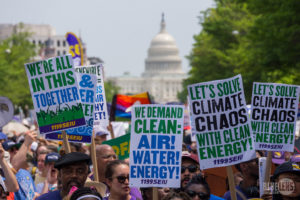The Green New Deal resolution was released in the House of Representatives by Representative Alexandria Ocasio-Cortez (D-NY) on February 7, 2019, with a companion measure introduced in the Senate by Senator Ed Markey (D-MA).
 The Green New Deal (GND) is a powerful idea that is reshaping the conversation in Washington about how to tackle the issue of climate change. How is it doing this? By tying it to a set of concepts and policies that are about alleviating economic insecurity, the most potent political force of our time.
The Green New Deal (GND) is a powerful idea that is reshaping the conversation in Washington about how to tackle the issue of climate change. How is it doing this? By tying it to a set of concepts and policies that are about alleviating economic insecurity, the most potent political force of our time.
By likening itself to Franklin Delano Roosevelt’s New Deal that came before it, the GND reminds people of a point in time when the United States needed a reset—a new social compact between government and society that recalibrated expectations, assured people of the government’s ability to lead, and gave confidence to a citizenry that government heard and took seriously its needs. It represents an opportunity to shake up what has become a stale policy environment that has proven itself unable to tackle some of the most pressing challenges facing society today.
As many analysts have pointed out, the GND is ambitious on three dimensions. Its scope is enormous, covering a complete overhaul of the nation’s energy system and a new approach to healthcare and employment insurance. The approach, while not fully fleshed out, is aggressive, with government mandates and market intervention taking a bigger role.
The pace is unprecedented, with a 10-year mobilization effort to try and achieve a goal of net zero emissions status by 2030. This pace is a valid cause for concern because it would be extremely hard to achieve, but it is also, in some ways, more appropriate given all that we know about what is required to deal with climate change. All of these considerations have led many who likely support the goals of the GND to caution against throwing out a more incremental approach in favor of “utopian” visions and moonshots.
The aforementioned concerns have genuine merit, but to squander the energy and vision of a GND out of an abundance of caution is a mistake. It could be a big idea that needs to grow to reach its full potential and avoid several pitfalls that could limit its effectiveness.
Any ostensible “solution” to climate change that a) doesn’t acknowledge the power and necessity of carbon-fee-and-dividend, or even entertain the idea, b) doesn’t even acknowledge the CONCEPT of intermittent power… Read more »
I like the idea that Democratic politicians are thinking big about the need to address climate change, but the “Green New Deal” is not a practical approach to solving the… Read more »
The proposal for a “Green New Deal” to achieve net zero greenhouse gas emissions in the United States within a decade is a laudable example of climate change leadership. It… Read more »
The Green New Deal is more likely to sink any chance of stopping greenhouse gas emissions rather than help. For historical reference, the original New Deal goal was to end… Read more »
Hi Charles, I’m with you that taxing carbon to account for its environmental and human health damages would be the efficient way to cut CO2 emissions. And that’s what most… Read more »
Marilyn: You are correct that both carbon taxes and mandates can be made to work… in fact, both must be made to work. A carbon tax is easy and fast… Read more »
Pushing the GND on climate change will demonstrate how unrealistic it is and may have the result of provoking a serious debate. No where does any advocate indicate what effect… Read more »
So much of what I read now is about why clean energy can’t be done, or that goals are out of reach. That thinking appears to be siloed, old thinking,… Read more »
The Green New Deal and its detractors missed the boat. The fastest and most cost-effective approach to reduce greenhouse gas emissions, is high-value energy. What is missed is the 8000… Read more »